Did You Know Leopards Live in
The leopard is an opportunistic carnivore. If you're wondering what leopards eat, the answer is a long, extensive list of creatures.
These fur-ocious animals feast on nearly anything that comes in their mode, from tiny dung beetles to full-sized antelopes.
Not to exist confused with jaguars or cheetahs, you tin can recognize leopards past the black rosettes speckled on their fur coats.
Despite beingness the smallest in size of all the big cats, leopards are strong and elusive. They can hunt on prey double their size, killing them with one swift bite to the neck.
Leopards have a flexible diet encompassing giant elands, baboons, reptiles, and even birds if necessary. They're often considered "pests" by farmers for hunting domesticated livestock.
Without further ado, permit's bound right into the leopard'south diet and as well talk over some interesting facts about them.
A Leopard'due south Diet Might Surprise You
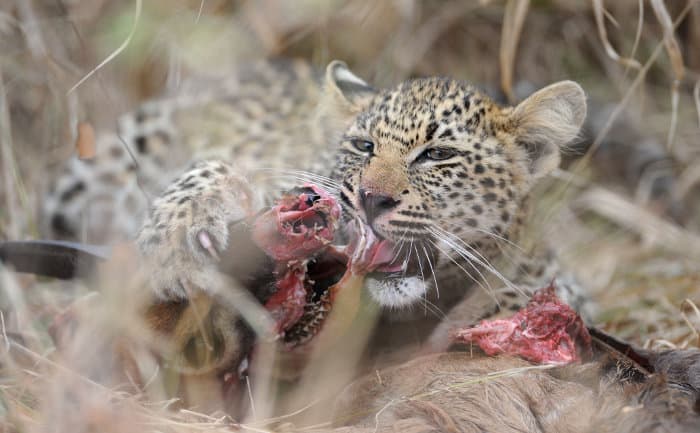
Leopards are certainly neither picky nor restrictive when information technology comes to filling their tummies. They can eat over 90 different species, commonly preying on medium to pocket-sized-sized creatures.
They have a pretty salubrious ambition so they try to hunt large prey, but those are ofttimes difficult to come across in the wild.
Eating various meat allows leopards to proceeds the necessary nutrients from all the animals they swallow, who likewise accept an all-encompassing colorful diet.
What does a leopard eat in the wild?
As carnivores mainly living in grasslands or savannas, their preferred meals are ungulate animals, similar antelopes, gazelles, and buffalo. They're likewise addicted of other mid-sized animals like deer, warthogs, and primates.
In mountainous regions, leopards banquet on animals like porcupines, rodents, and stone hyraxes. In rainforests, they opt for antelopes. On islands, they have a more fish-focused diet.
Leopards who don't live on islands are not very fond of swimming. So, they'll prey on fish only if they demand to. They'll swim in rivers or dams and snack on just most any fish species they observe.
In extreme cases, leopards hunt crocodiles from rivers and even dine on lizards and snakes. Although rare, this happens if leopards experience severe hunger.
The same goes for leopards eating insects, who merely practise and so when they don't take many food options at their disposal.
As one of the strongest climbing cats, leopards can ascend copse to catch birds or consume their chicks and eggs.
They can too effortlessly climb mountains and rocky cliffs and are light-footed enough to brand high jumps from the footing. This agility enables them to jump upwardly to take hold of birds in flight.
Their hunting choices are adjustable depending on their environmental setting and the food availability therein.
If food is scarce, leopards opt to hunt more abundant casualty, whether they're desirable or non. This allows them to thrive in different settings and switch up their menu equally and when needed.
What does a leopard swallow in captivity?
Leopards in captivity usually swallow carrion sourced from local farms.
This meat could include more behemothic animals similar giraffes and antelopes, or livestock animals like cows and horses.
Captive leopards feed on different types of mankind to be as good for you and fit every bit their wild counterparts.
What exercise infant leopards eat?
Baby leopards, also called cubs, are born blind and helpless. They're nursed past their mothers, who begin feeding them solid parts around the second calendar month. By month three, the female parent starts teaching her cubs how to hunt.
These cubs stay with their female parent until they're 12 or eighteen months old. Subsequently which, they start living on their own and fending for themselves.
Leopard's Nutrient: A List of Their Favourite Meals
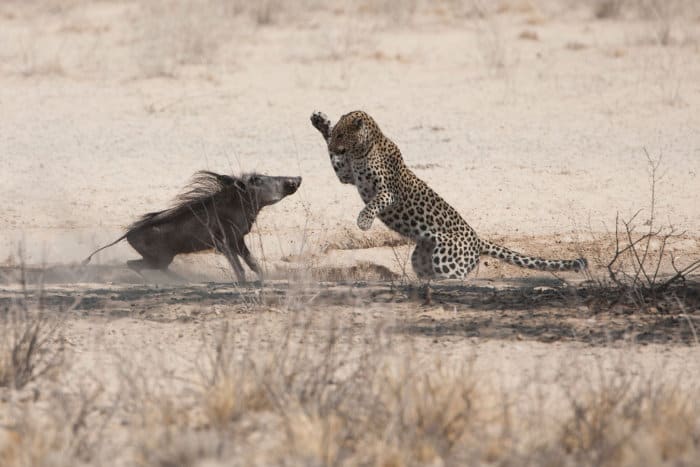
What'southward on the carte for leopards? They'll suit their taste buds and hunting techniques to source nutrient that is native to the area they are living in.
Here's a complete list of everything they eat:
- Fish.
- Birds including pheasants, guineafowl, and other smaller birds.
- Reptiles including snakes, lizards, and crocodiles.
- Rodents including mice, rats, rabbits, and hares.
- Pocket-sized to medium-sized animals like monkeys, baboons, warthogs, antelopes, zebras and porcupines.
- Insects like termites, dung beetles, moths, butterflies, grasshoppers, caterpillars, flies, maggots, and more.
- Livestock like sheep, goats, calves, lambs, pigs, geese, and poultry.
- Carrion stolen from other animals like hyenas, jackals, wild dogs, etc.
How Much Practise Leopards Consume in a Day?
Leopards don't feed every single day. They'll feast for a day and then spend the next few days digesting that food.
If they score a big meal, they tin go thirteen-18 days earlier hunting once more.
This survival tactic works well for them considering new prey isn't available to chase every mean solar day.
Leopards Hunting Style and Habits
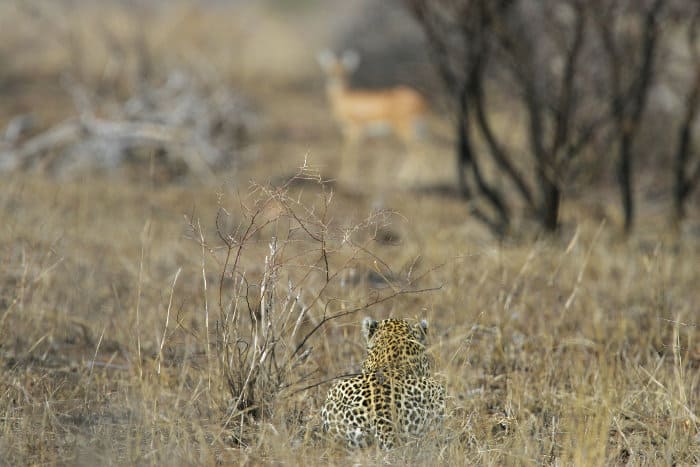
Leopards prefer to chase medium to small-sized casualty. If necessary, they may steal carcasses from other animals like hyenas, jackals, and wild dogs.
They by and large steer clear in stealing from lions or a big pack of predatory animals since leopards hunt alone.
Leopards have a slow and sneaky style of hunting. They patiently stalk their prey and crouch low in shut proximity until they're set up to attack.
The golden glaze with the rosette-shaped design allows them to camouflage in the wild. When set, they pounce and become directly for the neck. The prey has no chance to react.
Thus, they rely on their power to camouflage and their strength when hunting. Powerful jaw muscles allow leopards to impale large prey with just a bite to their neck. One seize with teeth is sufficient to break their prey's neck and then suffocate to kill them.
Leopard's Nutrient Competitors
A leopard's diet is similar to that of lions, African wild dogs, and hyenas. All these animals compete with each other for territory – which means access to food.
These same animals can also go predators to leopards if in that location'due south a shortage of food. Lions, African wild dogs, and hyenas prey on cubs for food and kill adult leopards when competing for territory.
Did you know that leopards are likewise cannibalistic? Male leopards may kill and eat the carcass of the younger leopards in order to decrease territorial contest.
African Leopard Facts
With their sharp teeth, claws, and strong muscles, leopards are remarkable animals. They accept a wild palette that'due south easy to satisfy, eating whatever's necessary to have their fill up.
Here are some more exciting facts nearly African leopards.
one. Where exercise leopards live?
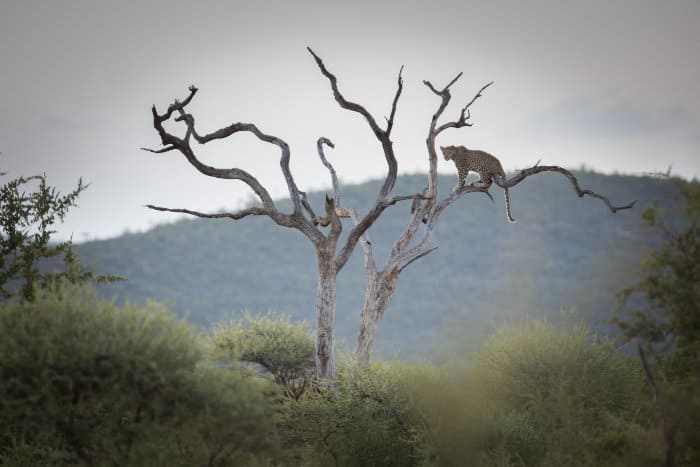
Just like their hunting style, leopards are very adaptable when information technology comes to their habitat and location. They can live in many dissimilar places all across the world. In fact, they alive in more places than any other big cat.
You tin spot leopards in sub-Saharan Africa, the Arabian Peninsula, southwestern and eastern Turkey, Southwest Asia, the Himalayas, Republic of india, China, Russia, and Sri Lanka.
Leopards alive beyond many different habitats, including grasslands, swamp areas, shrublands, savannas, forests, woodlands, rainforests, mountains and deserts.
ii. What does a leopard look like?
Leopards are often confused with cheetahs, who have more round or oval-shaped solid spots.
On the other hand, leopards have a fur coat speckled with singled-out spots, chosen "rosettes" for their resemblance to the rose shape. These rosettes accept no set pattern.
Most leopards are light-colored. Blackness leopards are often confused with blackness panthers because their spots cover-up with their dark coat.
three. Leopard's active speed
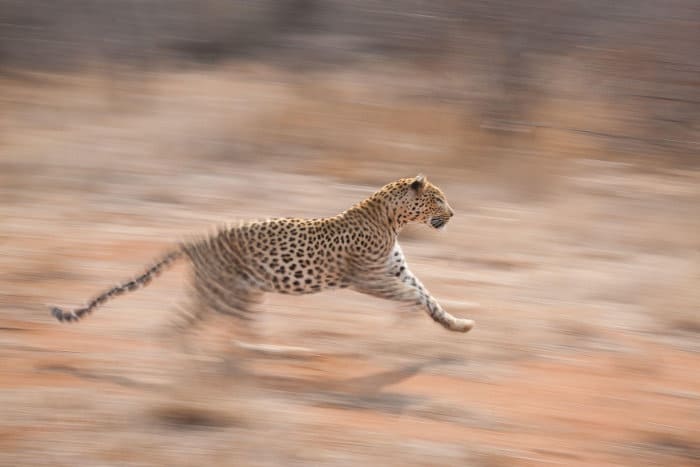
Accept you ever wondered how fast a leopard can run? They have acme speeds ranging between 56-60 km/h (35-37 mph).
This is significantly slower than cheetahs, who can run up to 120 km/h (74.five mph).
It's close to a jaguar and panthera leo, who have recorded top speeds of 80 km/h (49.7 mph).
4. A leopard's social life
A leopard's social life is almost non-existent. They prefer to live and chase alone. Each one has its territory, which it marks by leaving scratches on copse or a urine scent. This lets others know to stay away.
Leopards are like depression-maintenance friends who only text once a month. They don't require much attending and prefer keeping to themselves.
5. Can leopards climb trees?
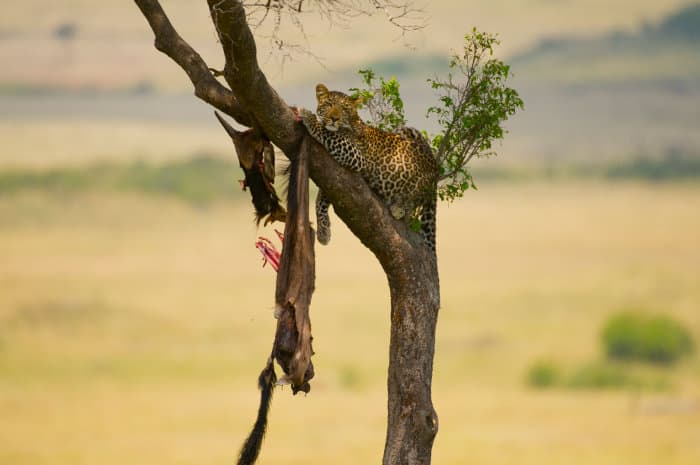
Yeah, leopards tin climb trees. In fact, they're one of the nigh skilled climbers amidst cats.
They can easily drag carcasses up into trees and gorge on them while resting on a branch.
Enjoying their meal from atop a tree protects information technology from thieving hyenas and lions.
6. Exercise leopards sleep during the day?
Yeah, leopards are mainly nocturnal animals. They're agile at night, and this is when they do almost of their hunting.
They spend their days sleeping or resting. On some occasions, they may hunt during the twenty-four hours.
7. How practice leopards communicate?
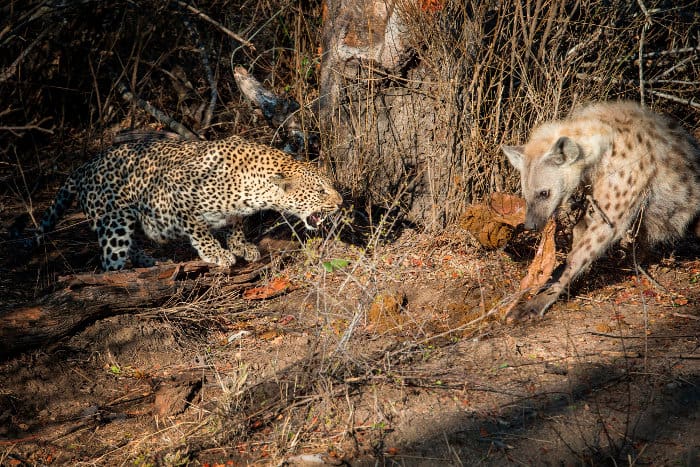
Leopards communicate through distinctive calls. When angry, they growl. When happy, they purr like domestic cats. To make some other leopard enlightened of their presence, they make a hoarse, raspy cough.
8. How Long Do Leopards Live?
Leopards can go for many days without drinking or eating. In the wild, leopards live for about 12 to 15 years. In captivity, they can impressively live for up to 23 years.
The IUCN'south Red Listing of Threatened Species classifies leopards as not yet endangered but "vulnerable."
Despite living in many places across the globe, leopards are slowly decreasing in population. The reasons backside their declining population are habitat loss and hunting.
Interesting Facts About Leopards and Their Unusual Diet
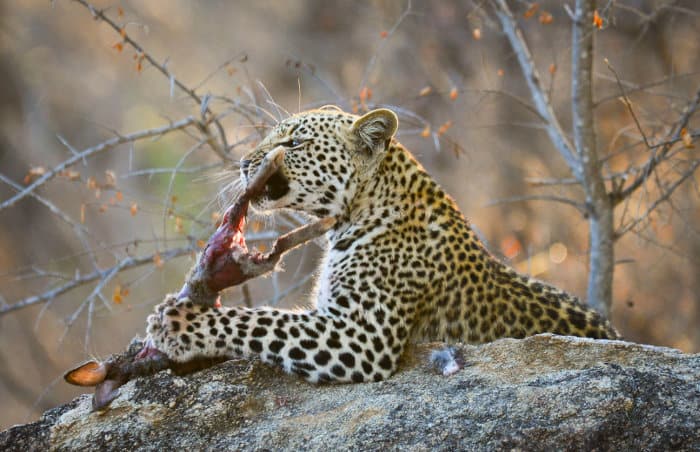
And there you have it folks, all the information about leopards and their eclectic diet.
A leopard'south nutrition is adjustable and flexible. Information technology covers a wide collection of different kinds of meat and creatures. Leopards volition eat whatever's necessary to satiate their hunger and gain maximum nourishment to stay total of energy.
Hopefully, you found these fun facts on leopards interesting and educational. Book a safari today and spot a leopard in the wild!
Source: https://africafreak.com/what-do-leopards-eat
0 Response to "Did You Know Leopards Live in"
Post a Comment